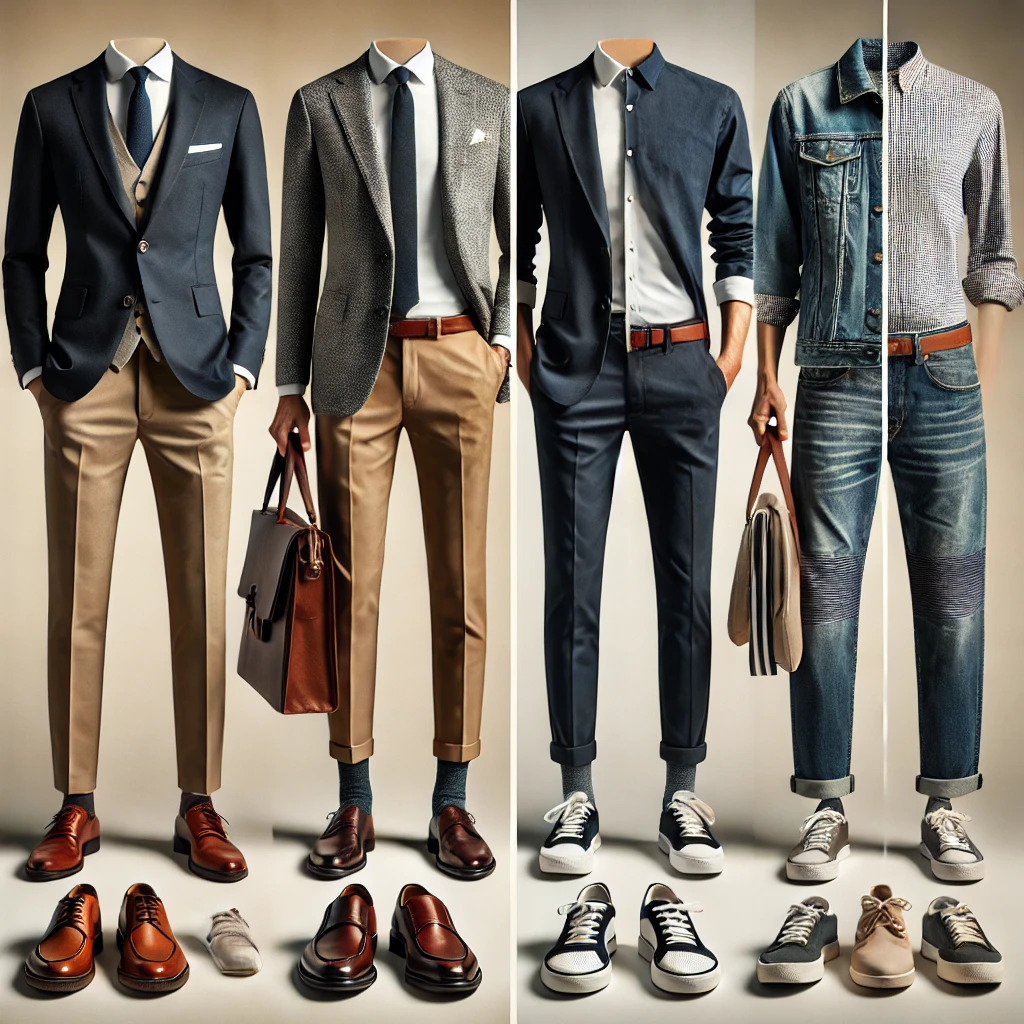Whether you’re dressing for a typical workday, a job interview, or a special event, selecting the right outfit is key to feeling confident and making a lasting impression. Two of the most common dress codes in today’s professional environments are business casual and smart casual. Understanding the differences between these two styles will help you make informed decisions about your wardrobe and ensure that you’re dressed appropriately for any occasion. In this guide, we’ll break down business casual vs. smart casual attire, highlight their similarities and benefits, provide outfit ideas for both, and share tips on how to incorporate your personal style into each.
What is Business Casual Attire?
Business casual attire strikes a balance between traditional business wear and more relaxed, comfortable pieces. It’s often worn in office environments where suits may not be necessary, but professionalism is still a must. Examples of business casual outfits include collared shirts, khakis, blouses, and dress pants. You’ll typically see this dress code in industries like tech, education, and corporate settings where formality is a bit toned down.
Key elements of business casual for men include:
- Pants: Tailored dress pants, khakis, or pressed slacks are common. Some offices also accept well-fitted, dark-wash jeans.
- Shirts: Button-down shirts, sweaters, and even polo shirts are acceptable. Ties are optional but can add a professional touch.
- Shoes: Loafers, dress shoes, and clean, polished sneakers fit within the business casual spectrum.
Business casual ideas for women include:
- Pants and skirts: Dark denim, dress pants, or knee-length skirts. Pencil skirts and A-line skirts are perfect choices.
- Tops: Button-down blouses, blazers, cardigans, or modest sweaters are typical. Sleeveless tops are often fine when layered with a blazer or cardigan.
- Footwear: Closed-toe flats, loafers, and pumps are ideal for business casual attire.
What is Smart Casual Attire?
Smart casual attire is a notch more relaxed than business casual, incorporating trendy and fashionable elements into a professional outfit. It allows for more creativity and self-expression while still maintaining a polished, put-together look. This style is often seen in industries with more flexible dress codes, such as creative agencies, tech startups, or casual business environments.
Smart casual attire for men might include:
- Pants: Well-tailored jeans, chinos, or casual slacks. Avoid overly distressed or ripped jeans.
- Shirts: T-shirts, Henleys, or button-downs layered with blazers or jackets are great for a smart casual look.
- Shoes: Stylish sneakers, loafers, or even dressy boots can work well in a smart casual outfit.
Smart casual outfit ideas for women include:
- Bottoms: Stylish jeans, midi skirts, or dress pants. You can get more playful with patterns and prints compared to business casual.
- Tops: Chic blouses, t-shirts with blazers, and statement sweaters are perfect for a smart casual vibe. Look for interesting textures and cuts.
- Shoes: Fashionable flats, sneakers, or ankle boots can complete the smart casual look while keeping it comfortable.
Similarities Between Business Casual and Smart Casual
While business casual and smart casual have distinct differences, they share common ground when it comes to comfort and flexibility. Both styles allow you to express your personal taste without compromising professionalism. They are also popular dress codes in industries with more relaxed workplace cultures, such as tech, media, and hospitality.
Benefits of Business Casual and Smart Casual Attire
1. Affordability:
Unlike formal business suits, business casual and smart casual outfits tend to be more budget-friendly. By mixing and matching key wardrobe staples like trousers, shirts, and blazers, you can create multiple outfits without overspending.
2. Self-Expression:
Both business and smart casual allow you to showcase your individual style, whether it’s through accessories, color choices, or fabric textures. These dress codes encourage a balance between professionalism and creativity.
3. Comfort:
Business and smart casual outfits are more relaxed, making them comfortable for long workdays or after-hours networking events. For example, chinos and loafers provide more mobility compared to a full suit and dress shoes.
Tips on Integrating Your Style into Business and Smart Casual
1. Choose the Right Colors
Your color palette should reflect the occasion and season. For business casual, neutral tones like navy, gray, black, and white are staples. In smart casual, you have more room for color, so feel free to experiment with jewel tones, pastels, and bold shades depending on your personal taste.
2. Mix Prints and Patterns
Prints can add an interesting twist to an otherwise plain outfit. For business casual, opt for subtle patterns like pinstripes or small checks. Smart casual offers more flexibility, so you can go for bolder patterns like florals, polka dots, or geometric designs.
3. Layering for Versatility
Layering is a great way to add dimension to both business casual and smart casual outfits. For example, a blazer over a turtleneck is a chic business casual option, while a denim jacket over a t-shirt instantly gives off a smart casual vibe.
4. Accessorize Thoughtfully
The right accessories can elevate your outfit while still keeping it professional. Watches, belts, and scarves are great for adding a touch of personality to business or smart casual looks. Minimalist jewelry, structured bags, and stylish yet comfortable shoes help complete the ensemble.
Business Casual and Smart Casual: Final Thoughts
Choosing between business casual and smart casual comes down to understanding your environment and the expectations of your role. While business casual is slightly more formal, smart casual allows for more flexibility and personal expression. Both dress codes offer the opportunity to feel confident and comfortable, whether you’re attending an important meeting, going to an interview, or simply navigating a typical workday.
By investing in key wardrobe pieces and knowing how to mix and match them, you can master both styles with ease. And remember, it’s not just about following a dress code—it’s about making the code work for you.
For more fashion tips, check out our comprehensive guides on dressing for the workplace at MaxMetaSmart.com.
